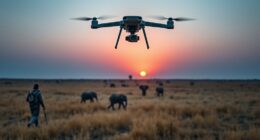Animal senses are incredibly strong and finely tuned for survival. Dogs, for instance, can smell compounds at one part per trillion, while wolves hear sounds from far away, enhancing communication. Cats excel in low light with superior vision, and touch plays a crucial role in social bonding among species. Each sense has evolved uniquely, allowing animals to thrive in their environments. If you're curious about how these senses interconnect across different species, there's much more to explore.
Key Takeaways
- Animals possess highly specialized senses, with dogs having over 100 million olfactory receptors for detecting scents far beyond human capability.
- Hearing enables detection of predators and communication, with wolves hearing sounds up to 25,000 Hz from great distances.
- Touch plays a crucial role in social interactions, as seen in primates grooming and elephants using trunks for tactile communication.
- Vision varies among species; cats excel in low light, while peregrine falcons can spot prey from a mile away.
- Sensory adaptations evolve through natural selection, allowing animals to integrate multiple senses for enhanced environmental awareness and survival.
The Power of Smell in Animals

Smell is an essential sense for many animals, playing an important role in their survival and communication. It evolved around 500 million years ago, allowing animals to detect airborne molecules through specialized olfactory receptors in their nasal cavities. This sense helps you identify predators, prey, and potential mates while alerting you to environmental hazards. Different species exhibit unique olfactory systems; for instance, dogs have over 100 million receptors, while humans have about 6 million. Additionally, canines can detect volatile organic compounds at one part per trillion (ppt), showcasing their remarkable olfactory capabilities. Aquatic animals, like fish, utilize olfactory rosettes to sense odors in water. The adaptation of your smell to your environment enhances your ability to thrive, making it a crucial tool for survival in the wild.
The Importance of Hearing for Survival
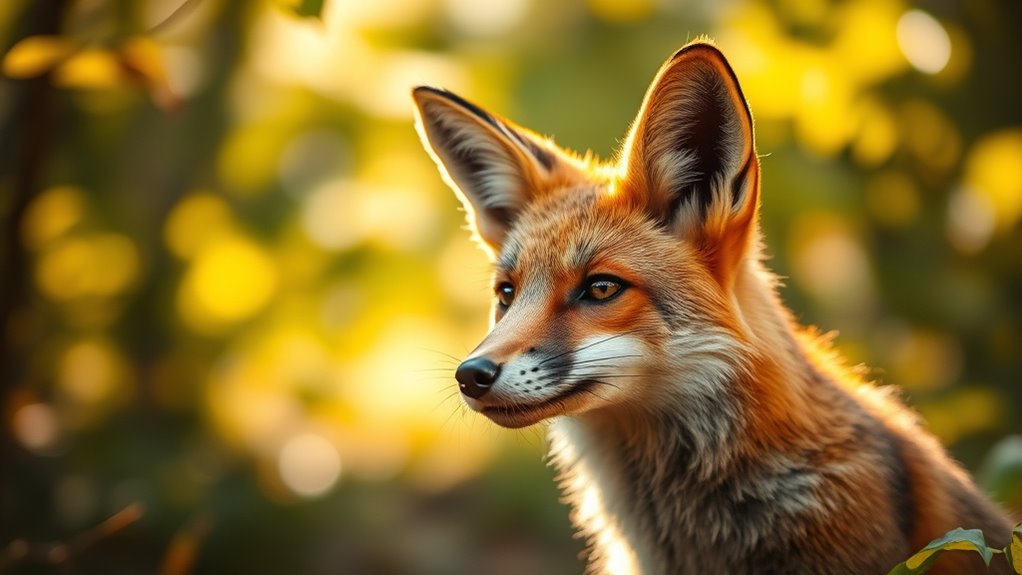
As animals navigate their environments, hearing plays an essential role in their survival, much like the power of smell. For instance, wolves can detect sounds up to 25,000 Hz, spotting predators from nearly 9.7 kilometers in forests or 16.1 kilometers in open areas.
Similarly, rabbits rely on their acute hearing to sense danger and escape effectively. In fact, moths can hear frequencies as high as 300,000 Hz, showcasing the incredible adaptations in the animal kingdom for evading predators.
Owls, with their asymmetrical ears, pinpoint sound sources, enhancing their hunting success at night.
Toothed whales use echolocation, emitting high-frequency sounds to locate prey underwater.
Overall, sharp hearing not only aids in predator detection but also facilitates communication, allowing animals to thrive in their habitats.
With these adaptations, hearing becomes an essential survival mechanism across various species.
The Role of Touch in Animal Interaction
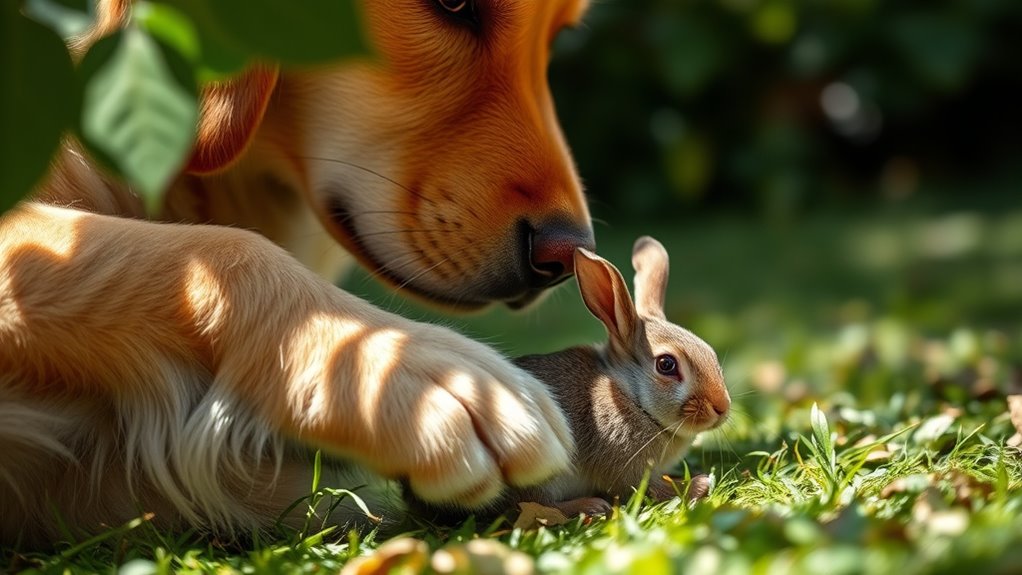
Touch plays an essential role in how animals interact, influencing their social structures and emotional well-being.
For primates, grooming not only maintains hygiene but also strengthens bonds. Elephants use their sensitive trunks to caress and reassure each other, crucial for family cohesion. Tactile communication helps in resolving conflicts, allowing animals to mend relationships after disputes.
Cats and dogs communicate through nudges and scratches, while ants rely on their antennae to convey important information. Birds, like Apostlebirds, preen each other to foster cooperation.
Overall, touch enhances survival by promoting cooperation and reducing stress. It helps resolve conflicts, guarantees group coordination during activities, and strengthens social ties.
Understanding these tactile interactions can improve your relationship with animals, highlighting the significance of gentle touch in fostering harmony.
Vision: Navigating the World

When you think about animal vision, consider how cats use their superior binocular vision to judge distances accurately while hunting. In contrast, dogs benefit from a wide field of view, allowing them to detect movement and potential threats from various angles. These unique visual adaptations help each species navigate their world effectively. Additionally, many species of bats utilize visual perception as a secondary backup to their primary echolocation, showcasing the diverse strategies animals employ for navigation.
Cats' Superior Binocular Vision
Cats possess remarkable binocular vision that sets them apart as efficient hunters in their environment. With their forward-facing eyes, they enjoy several advantages:
- Depth Perception: This vision allows them to judge distances accurately, essential for pouncing on prey.
- Hunting Efficiency: Pinpoint accuracy in tracking movement makes them skilled predators.
- Wide Visual Field: Cats have a 140-degree binocular field and a total visual field of about 200 degrees, providing thorough awareness of their surroundings. Their ability to see in low light also aids in hunting during dusk and dawn when they are most active.
This combination of features enhances their ability to detect motion and respond quickly, which is crucial for survival.
Dogs' Wide Field Advantage
Dogs enjoy a remarkable advantage in traversing their world thanks to their wide field of vision, which spans from 240 to 270 degrees depending on the breed.
This expansive view helps you detect movement and potential threats from the sides, making it easier to spot prey or dangers lurking nearby. Their eyes are positioned on the sides of their heads, enhancing peripheral vision but reducing depth perception. While they see primarily in shades of blue and yellow, their ability to detect motion is far more essential than color. Additionally, dogs excel in low-light conditions, thanks to a reflective layer behind the retina, which is due to their superior night vision.
This combination of traits makes your canine companion an exceptional navigator in various environments.
The Complexity of Taste in Different Species
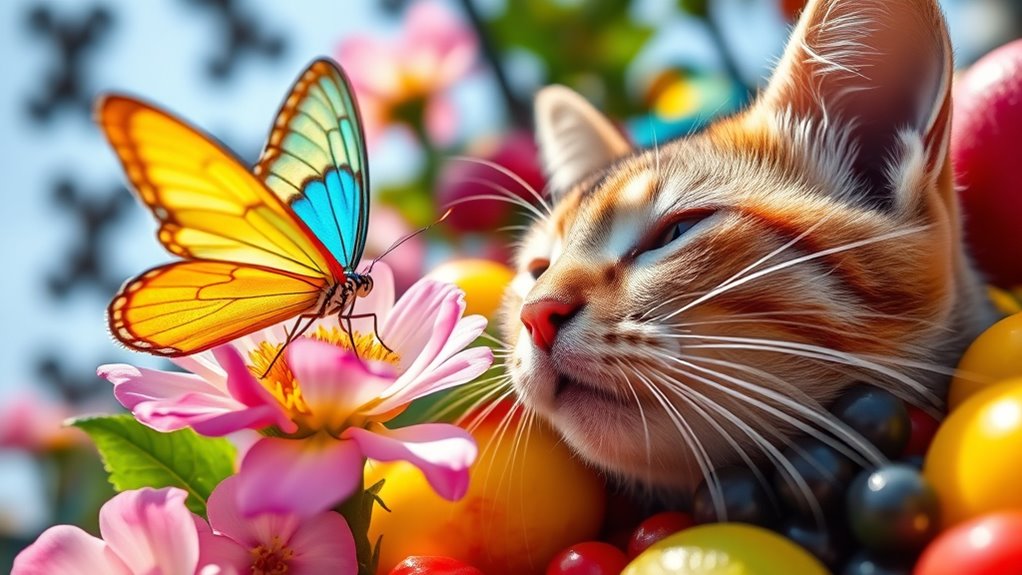
When you explore the complexity of taste in different species, you'll notice some fascinating differences in taste bud counts and flavor detection. For instance, herbivores boast a staggering number of taste buds compared to carnivores, impacting their ability to identify toxic plants. Additionally, the ability to detect toxins plays an essential role in how animals perceive flavors in their environments. Plus, the connection between taste and smell plays an essential role in how animals perceive flavors in their environments.
Taste Bud Comparisons
Taste bud comparisons reveal a fascinating diversity in how different species perceive flavors. You might be surprised to learn that:
- Taste Bud Composition: Different species have varying types and distributions of taste buds, affecting their ability to sense flavors.
- Genetic Variations: Taste receptor genes can differ greatly, leading to unique taste experiences—some animals excel in detecting sweetness, while others are more sensitive to bitterness. For instance, felines lack a functional gene for sweet flavor detection, which contributes to their indifference to sweets.
- Adaptive Evolution: Species like hummingbirds have evolved specialized receptors to thrive on sugary diets, showcasing how taste adaptations reflect dietary needs.
Understanding these comparisons helps you appreciate the complexity of taste across the animal kingdom and how evolution shapes flavor perception.
Flavor Detection Variations
While many animals share a basic ability to detect flavors, the nuances of flavor perception can be strikingly different across species. For instance, carnivores like cats have lost sweet taste receptors due to their dietary needs, while hummingbirds have repurposed umami receptors to identify sugar. These adaptations highlight how taste preferences evolve based on ecological niches.
Additionally, mammals possess unique T1R and T2R receptors for sweet, umami, and bitter flavors, yet their genetic variability leads to distinct taste experiences. Insects, such as fruit flies, even have taste pathways sensitive to carbon dioxide, showing how diverse flavor detection can be. Moreover, these variations in flavor perception are crucial for food quality assessment as they influence dietary choices and feeding behaviors across different species.
Ultimately, these differences in taste modalities reflect each species' nutritional requirements and evolutionary history.
Taste and Smell Connection
Understanding the connection between taste and smell reveals how intricately animals perceive their environments. These senses work together to form a thorough flavor experience, affecting dietary choices and survival. Here are three key aspects of this connection:
- Interconnected Senses: Taste and smell combine to create flavor, meaning you can't fully appreciate food with a blocked nose.
- Adaptive Value: The ability to differentiate tastes helps animals select nutritious foods and avoid toxins. This is crucial because smell aids in sensing food, allowing animals to assess their nutritional choices even before tasting.
- Species-Specific Traits: Some animals, like snakes, utilize structures like the Jacobson's organ to enhance their taste-smell capabilities.
Adaptation of Senses Across Species
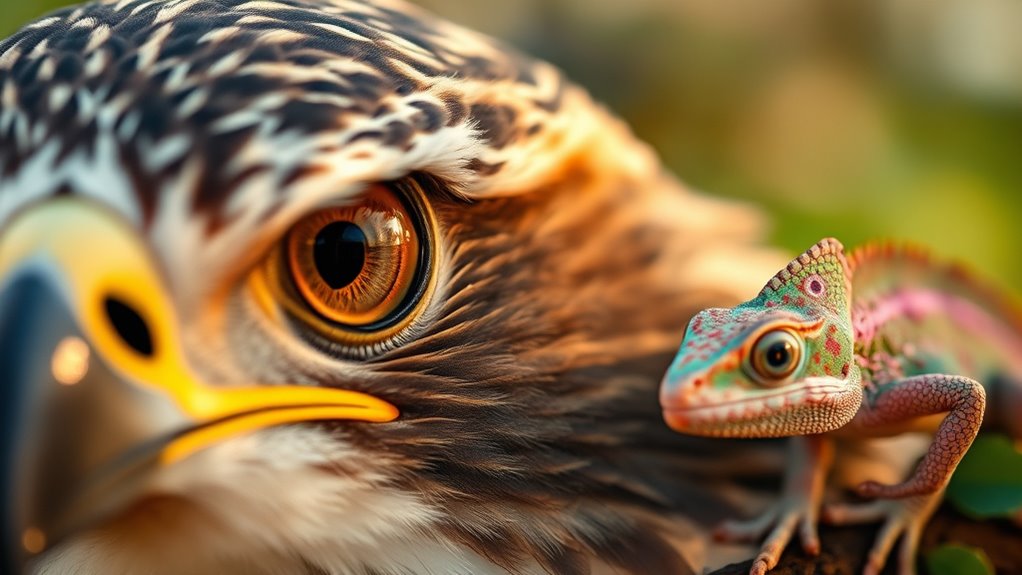
Animals have evolved remarkable adaptations in their senses, allowing them to thrive in diverse environments. For instance, the Peregrine Falcon can spot prey from a mile away, while the Peacock Flounder changes color to blend into its surroundings. In the underwater world, Octopuses and Mantis Shrimp excel at detecting polarized light. Additionally, these adaptations have developed over time through natural selection, enhancing the animals' survival capabilities.
| Vision | Hearing |
|---|---|
| Peregrine Falcon | Bats use echolocation |
| Peacock Flounder | Elephants hear infrasound |
| Mantis Shrimp | Dolphins navigate with clicks |
Similarly, Bloodhounds' sense of smell is unmatched, and cats' whiskers enhance their tactile perception. These adaptations illustrate nature's creativity in helping animals survive and thrive in their respective habitats.
The Interconnectedness of Animal Senses
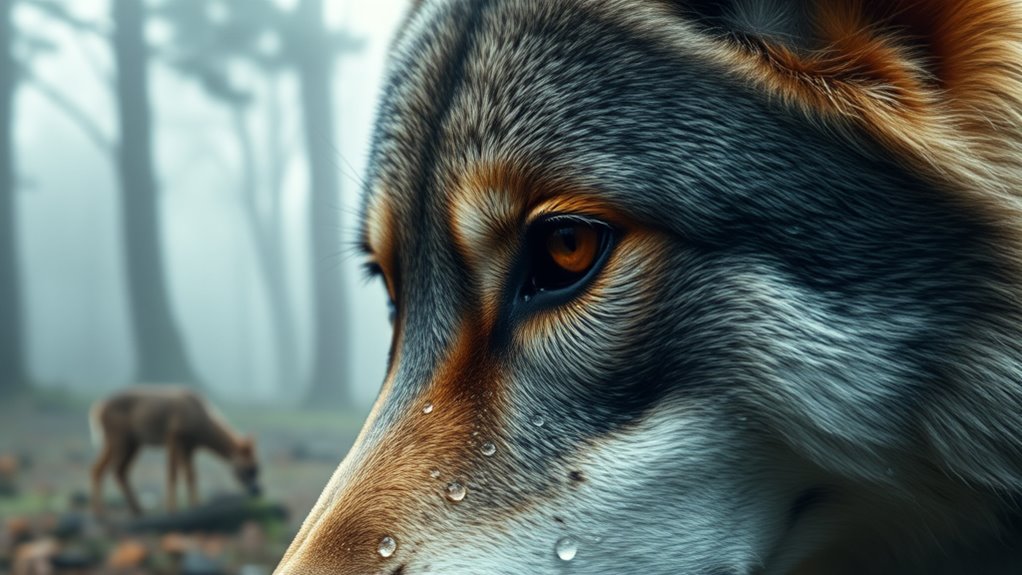
Although you may not always realize it, the interconnectedness of animal senses plays a crucial role in how creatures interact with their environment. This sensory integration enhances perception and response, making survival more efficient.
Here are three key aspects to take into account:
- Cross-Modal Processing: Animals often combine senses, like sight and sound, to form a complete understanding of their surroundings. For example, mechanoreceptors in the ear help detect sound waves, which can be integrated with visual cues for better spatial awareness.
- Neural Pathways: Specific pathways in the brain connect different sensory inputs, allowing for seamless information processing.
- Behavioral Adaptations: Interconnected senses influence how animals behave, whether foraging, steering, or communicating.
These mechanisms not only increase an animal's chances of survival but also shape their ecological interactions, highlighting the importance of sensory integration in the animal kingdom.
Frequently Asked Questions
How Do Animal Senses Vary by Species and Environment?
Animal senses vary greatly by species and environment, adapting to their specific needs.
For example, you might notice predators have sharper vision for tracking prey, while prey animals possess wider vision to spot threats.
In water, fish rely on pressure changes, while elephants can hear infrasound to communicate over long distances.
Each sense enhances survival, helping animals find food, avoid danger, and interact with their surroundings effectively, showcasing the incredible diversity of adaptations in nature.
Can Animals Lose Their Sense of Smell or Hearing?
You know the saying, "Out of sight, out of mind"? Well, animals can also lose their sense of smell or hearing.
Various factors, like injury or environmental noise, can cause this loss, impacting their survival. For instance, a dog may struggle to find food without its keen sense of smell.
Fortunately, researchers are exploring restoration techniques, such as gene therapy and stem cell treatments, offering hope for affected species to regain their essential senses.
How Do Senses Influence Animal Behavior and Social Structures?
Your senses considerably influence your behavior and social structures. They help you recognize others, communicate effectively, and establish hierarchies within your group.
For instance, you rely on sensory cues to identify mates or defend your territory. When you detect social signals, it fosters cooperation and strengthens bonds.
Additionally, your sensory experiences shape your learning and memory, allowing you to adapt to your environment and enhance your overall survival.
What Are the Evolutionary Advantages of Heightened Senses?
Heightened senses offer you significant evolutionary advantages. They improve your ability to detect prey, navigate environments, and communicate effectively.
With enhanced senses, you can recognize social cues and strengthen group bonds, ensuring better survival. Additionally, early detection of threats helps you evade danger.
These adaptations not only enhance your hunting skills but also allow for more complex social structures, ensuring that you thrive in diverse ecosystems and develop innovative survival strategies.
Do Animals Have Preferences for Certain Sensory Inputs Over Others?
Absolutely, animals definitely have preferences for certain sensory inputs over others.
For instance, you might notice that some animals are drawn to bright colors or specific scents, which can signal food or mates. These preferences often stem from evolutionary adaptations that help them survive and thrive.
Conclusion
In the grand tapestry of life, animal senses weave together a rich narrative of survival and interaction. You've seen how smell, hearing, touch, vision, and taste play essential roles in their lives, each sense finely tuned to their environment. As you explore the incredible adaptations across species, remember that these senses don't just operate in isolation; they're interconnected, creating a symphony that allows animals to thrive. Truly, in the wild, every sense counts for survival and connection.








